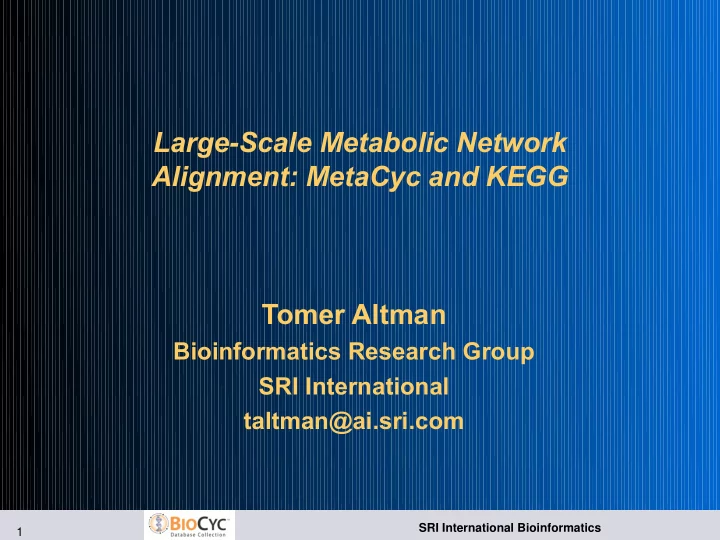

Large-Scale Metabolic Network Alignment: MetaCyc and KEGG Tomer Altman Bioinformatics Research Group SRI International taltman@ai.sri.com SRI International Bioinformatics 1
Problem Motivation There are an increasing number of ‘encyclopedic’ metabolic networks, or reaction databases KEGG and MetaCyc, plus Rhea, BRENDA, and GO A natural question to ask is, “what is similar / different between them?” There has been some linking of MetaCyc compounds to KEGG, but none for reactions up until 2009 SRI International Bioinformatics 2
Challenges with Mapping Objects Multiple aspects to compare (name, chemical structure, reaction substrates, external identifiers) Inexact naming Inexact structures (different specificity of stereocenters) Inexact description of reactions (classes vs. instances, proton-balancing) How to combine the evidence in a logical fashion SRI International Bioinformatics 3
Compound Evidence Curated MetaCyc links to KEGG Name matching PubChem identifier mapping (used for ChEBI as well) Molecular Fingerprint Tanimoto Similarity Coefficient InChI string comparison Exact Sub-Structure Match (no stereochemistry) ‘All-but-one’ inference SRI International Bioinformatics 4
Compound Prediction Detail: ‘All-but- one’ Most of the compounds between these two reactions are the same Class vs. instance, and naming issues lead to unknown match between “acceptor” and “oxidized electron acceptor” SRI International Bioinformatics 5
Reaction Evidence EC Numbers UniProt Accession Numbers Name matches (gleaned from associated objects) Exact equation match Inexact equation match (cosine similarity) SRI International Bioinformatics 6
Reaction Prediction Detail: UniProt Mapping Use UniProt Accession numbers to map the enzymes in MetaCyc and KEGG to one another Use UniRef 90 or 100 to map “the same protein” when not exact same Accession Number SRI International Bioinformatics 7
From Evidence to Prediction First approach involved bootstrapping the mapping by means of an ad-hoc algorithm that was tuned to be very conservative, and subsequent validation by curation staff Currently a machine learning approach to evaluating all of the features shared between reactions in Kegg and MetaCyc is being developed with collaborators at Stanford Evaluate features for information content Implement as Naïve Bayes, Logistic Regression, SVM, etc. to determine method with greatest predictive power Classify unmapped data with hierarchical clustering (i.e., unsupervised learning) Provide as general algorithm for comparing reaction databases SRI International Bioinformatics 8
Current Status and Future Work ### MetaCyc reactions with links to KEGG (~##%) ### MetaCyc compounds with links to KEGG (>## %) Analyzing unmatched content of KEGG and MetaCyc for algorithm improvement and focused curation Development of new features for machine learning analysis SRI International Bioinformatics 9
Acknowledgements • Peter Karp • Douglas Brutlag • Anamika Kothari • Carol Fulcher • Ron Caspi • Dan Davison • Luciana Ferrer • Joseph Dale MetaCyc.org SRI International Bioinformatics 10
Recommend
More recommend